“We must free ourselves of the hope that the sea will ever rest. We must learn to sail in high winds.” -Aristotle Onassis
Welcome back to the end of another big week at Starts With A Bang! There's been a lot of fantastic stories that have gone down, including:
- Can stars escape from the galaxy, with planets intact? (for Ask Ethan),
- Fossilized relic discovered by Hubble is a link to the Milky Way's past (for Mostly Mute Monday),
- Is the cosmic distance ladder flawed?,
- That's no comet; that's Pluto!,
- How certain are we of the Universe's 'Big Freeze' fate, and
- Was Earth born with life already on it?
For those of you who live in the Pacific Northwest, come see me give an all new public lecture on Tuesday, September 20th at 6:30 PM at the Winlock Timberland Library! The topic will be "Understanding the Cosmic Abyss," and it's going to be awesome!
I'm 100% set to go to the 229th AAS meeting the first week of this coming January, so you know it's a certainty I'll be bringing you all the latest and greatest discoveries at the country's biggest annual astronomy meeting, too. It's also been a relatively quiet week here, comment-wise, so that just gives me a chance to expound in more detail on the comments we do have. (But it also makes the argument for un-banning See Noevo, so if you're against that, better step it up over the next week!) With all of that said, let's move onto our comments of the week!
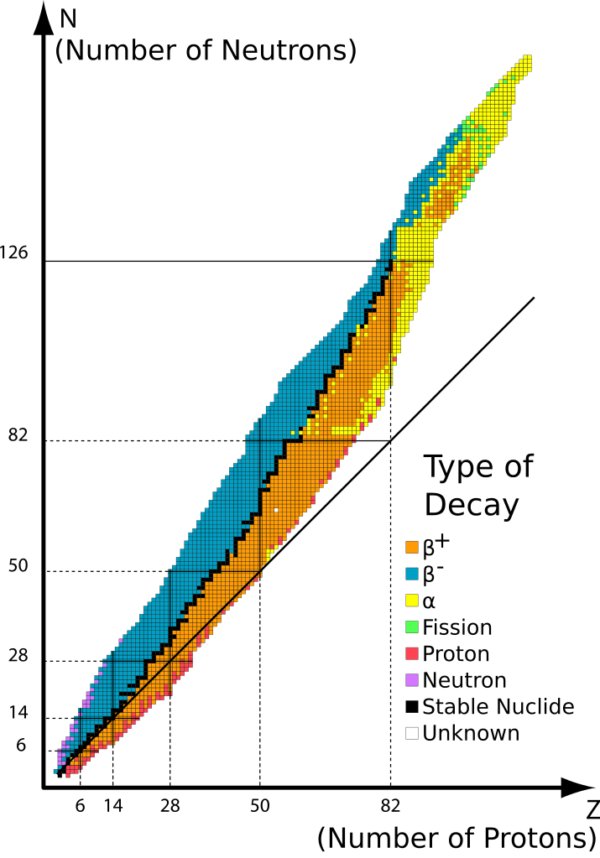 The radioactive decay products of the elements. Image credit: Wikimedia Commons users Napy1kenobi, Sjlegg, and Quibik.
The radioactive decay products of the elements. Image credit: Wikimedia Commons users Napy1kenobi, Sjlegg, and Quibik.
From axil on radioactive decays and neutrinos: "A geoneutrino is an electron antineutrino emitted in β− decay of a radionuclide naturally occurring in the Earth."
First off, although there are electron antineutrinos that are emitted from the Earth, that is not the full spectrum of neutrinos produced by radioactive materials on our planets. Not including the copious amounts of muon neutrinos and antineutrinos produced by cosmic rays, the elements on Earth also routinely produce electron neutrinos due to all the β+ decays that naturally occur on Earth. But if you're thinking, "oh, I can just look for the electron antineutrinos produced by β- decays in the Earth," you've got another think coming.
 Beta decay resulting from a neutron transforming into an electron, proton, and anti-electron neutrino. Image credit: Wikimedia commons user Inductiveload.
Beta decay resulting from a neutron transforming into an electron, proton, and anti-electron neutrino. Image credit: Wikimedia commons user Inductiveload.
Because even creating an antielectron neutrino doesn't guarantee you'll wind up observing an antielectron neutrino, thanks to the phenomenon of neutrino oscillations. Particularly if something originates in the Earth and passes through (i.e., interacts with) the intervening matter, there is a quantitative probability for it to oscillate into a muon and/or a tau antineutrino. If you want to throw out alternative explanations for "hey, what if there's some new physics here" going on, you'd better account properly for neutrinos and their oscillations as produced by geoneutrinos, cosmic rays and the Sun. Unless you do that first, you're going to draw whatever biased conclusions you're predisposed to.
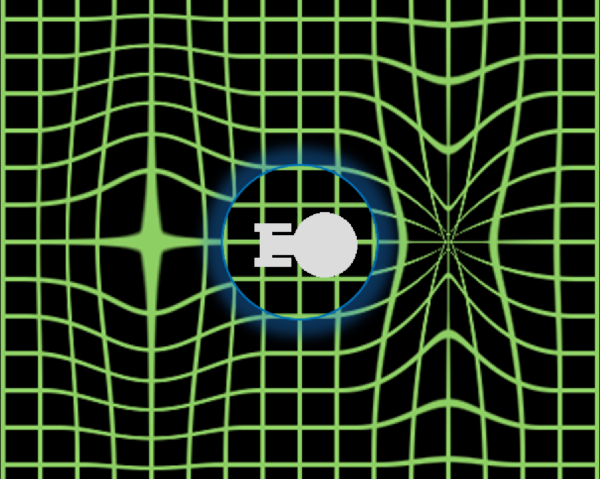 A warp field from Star Trek, which shortens the space in front of it while lengthening the space behind it. Image credit: Trekky0623 of English Wikipedia.
A warp field from Star Trek, which shortens the space in front of it while lengthening the space behind it. Image credit: Trekky0623 of English Wikipedia.
From eric on an objection to Star Trek's warp drive technology: "Doesn’t [warp travel] violate relativity’s ‘no absolute reference frame’ concept? You seem to be building an absolute time frame here."
The line of thinking is understandable, and highlights an important misconception people have when it comes to relativity. Most people think that "no preferred reference frame" means that the Universe should never appear more pleasing, simple, uniform, or easily-understood to an observer in one reference frame than another. And that's close; what it actually means is that the Universe should never appear to obey different laws or exhibit fundamentally different behaviors in one non-accelerating reference frame versus another.
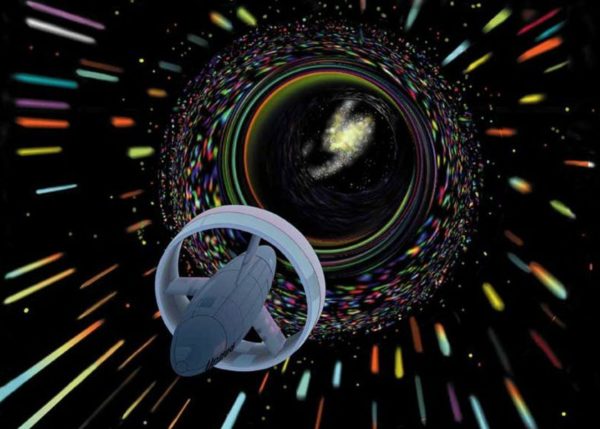 An artist's conception of a starship making use of the Alcubierre drive to travel at apparently faster-than-light speeds. Image credit: NASA.
An artist's conception of a starship making use of the Alcubierre drive to travel at apparently faster-than-light speeds. Image credit: NASA.
The ability to warp space to "short-cut" your way through the Universe doesn't change the laws of physics, nor does it change the rate at which time passes for you. In fact, from within your "warp bubble," all the laws of physics and all of your experience would be the same as for anyone well outside your bubble, or -- due to a fun twist of geometry -- anyone exactly perpendicular to your direction-of-motion. The ability to outrace a light signal doesn't mean there's a preferred reference frame, but it does mean that you need to be willing to pay the price (in terms of energy) to both warp and un-warp that space. It's not clear that this is feasible.
It's also worth pointing out that warp drive could lead to the ultimate advantage in forensic investigations. Let's say a murder occurred an hour ago when you find out about it. All you need to do is "warp" to, say, 65 light-minutes away, open up your super-powerful telescope and view the murder, and viola, the murderer is busted! "Getting away" with a crime would be virtually impossible.
From Omega Centauri on magnetic fields on Proxima b: "Ethan, both you and Sean seem to accept a scaling of planetary magfield strength with rotation rate. Is such a simple scaling law justified."
It very much is! Not because, with a rotation rate that's 9% that of Earth's, Proxima b couldn't have a magnetic field that's stronger (or weaker) than 9% of Earth's, but because it would require something different. Very generically, if you have some sort of charge distribution that rotates, it's going to give rise to a magnetic field. The strength of the field that you get is directly proportional to the rotational speed, meaning that if the Earth itself rotated at 9% of its current speed, we'd expect our magnetic field to be only 9% of its strength.
Assuming the core's dynamo processes are unchanged but its rotation rate drops correspondingly to the planet's overall rate, that scaling law is justified by Maxwell's equations. But other differences could exist, too, between Earth and Proxima b that could result in quite an impressive magnetic field!
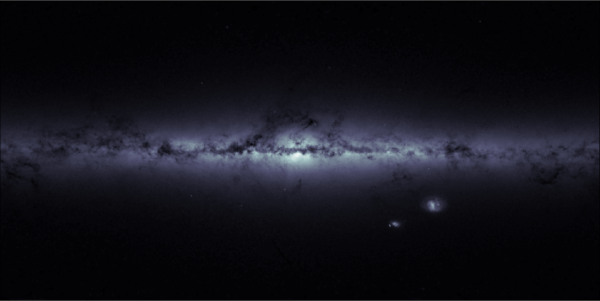 A map of star density in the Milky Way and surrounding sky, clearly showing the Milky Way, large and small Magellanic Clouds, and if you look more closely, NGC 104 to the left of the SMC, NGC 6205 slightly above and to the left of the galactic core, and NGC 7078 slightly below. Image credit: ESA/GAIA.
A map of star density in the Milky Way and surrounding sky, clearly showing the Milky Way, large and small Magellanic Clouds, and if you look more closely, NGC 104 to the left of the SMC, NGC 6205 slightly above and to the left of the galactic core, and NGC 7078 slightly below. Image credit: ESA/GAIA.
From Birgerjohansson on GAIA's upcoming discoveries: "But what I am really interested in is the treasure trove of planet discoveries. Since planets distant from their star will be favoured, it will fill in a gap in the planet detections."
Sure, a non-cosmologist would be more interested in distant planet-finding results than in the implications for the evolution of our Universe's expansion, and those are interesting results that will come about. Instead of using the transit method, which requires an alignment of a planet passing in front of its star, or the radial velocity method, which measures a parent star's wobble and gives a lower limit on the mass, GAIA takes advantage of astrometry, which is best for finding distant, face-on planets by imaging them directly. This is incredibly difficult, as the first astrometrically discovered planet, VB 10b, was only found in 2009, and was later refuted. (It is still regarded as contentious.)
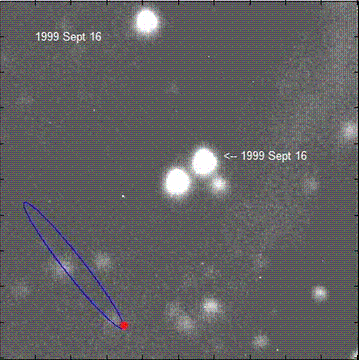 This movie shows the star VB 10 moving across the sky over a period of nine years. The blue ellipse shows the (magnified) orbit of the unconfirmed planet VB 10 b (red dot) and its movement relative to the star. Image credit: NASA / JPL-Caltech / Palomar.
This movie shows the star VB 10 moving across the sky over a period of nine years. The blue ellipse shows the (magnified) orbit of the unconfirmed planet VB 10 b (red dot) and its movement relative to the star. Image credit: NASA / JPL-Caltech / Palomar.
With a resolution of 20 µas, it's possible that GAIA will detect a large number of massive, bright, distant planets, marking humanity's entrance (at last!) into the robust detection of exoplanets via astrometry, but I wouldn't say it's a slam-dunk. It's a hope we have, but we've had this hope before with astrometry. Let's be excited, but let's keep that excitement tempered!
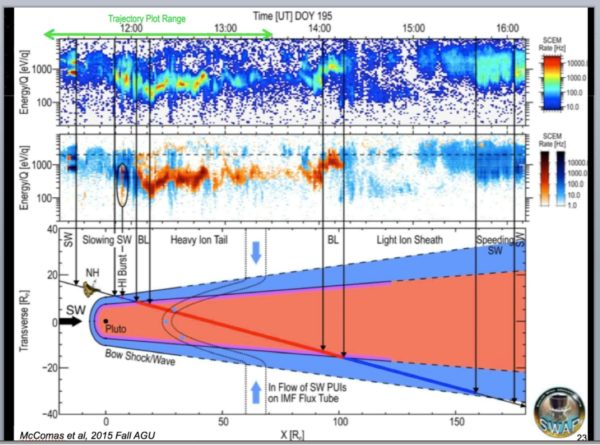 Pluto’s tail, as inferred from the New Horizons flyby in 2015. Image credit: McComas et al. (2016), for the New Horizons SWAP team.
Pluto’s tail, as inferred from the New Horizons flyby in 2015. Image credit: McComas et al. (2016), for the New Horizons SWAP team.
From Danny on Pluto's tail and X-ray emissions: "Which goes to show, that MPC-134340/Pluto is a “failed” comet just like every other TNO in the Kuiper Belt. It should lay to rest those who still say Pluto is a classical planet."
Well, hang on there. If Pluto were more massive -- massive enough to be a true planet instead of a dwarf planet -- it could still be at the same distance from the Sun and have a very similar composition to what it has now. If that were the case, it would still have a tail (an even larger one), it would still emit X-rays (even more than it does now), and it would still have cometary tendencies. Particularly if it exhibited a lack of a H/He envelope, which could be possible for many reasons, including tidal stripping, this scenario is entirely within the realm of possible, and may well be the case in other Solar Systems.
Pluto isn't a planet the way we'd want to define it simply because it isn't massive enough, not because of these new findings. Up the mass until it crosses the planetary threshold, and it would (and should) be a planet!
Organic molecules are found in interstellar space in many varieties. Image credit: NASA / JPL-Caltech / T. Pyle; Spitzer Space Telescope.
And finally, from Candice H. Brown Elliott on the notion that life began prior to Earth: "Combine this evidence with others and perhaps we are seeing evidence of panspermia?"
In particular, Candice referred us to this paper, which I remember when it came out around three years ago. What the authors did was very simple: they took the length/complexity of genetic code found within the most "advanced" organisms on the planet at the time and mapped -- on a log/linear scale -- how genetic information scaled with time. Here's what they got.
If you look at the "non-redundant, functional genome" instead of the total genome, you find a nice fit to this, indicating that perhaps something could have arisen randomly and successfully billions of years before the Earth formed, giving rise to what we know on Earth now. The fun part is that this can likely be tested by seeing if there are relics of some sort indicative of this on other worlds in our Solar System, somewhere in the range of 10,000 to 1,000,000 bp of genome size. (At least in principle.) You never know!
Thanks for a good week, hopefully I'll see some of you on Tuesday, and if all goes well, this month's podcast will go live for Patreon supporters soon! (And then for everyone else a week later.) And finally, step it up in terms of comments for next week, or See Noevo's ban gets revoked!

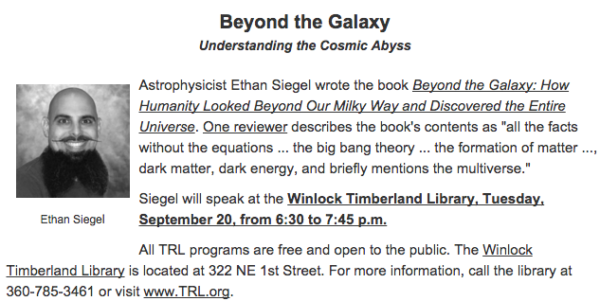
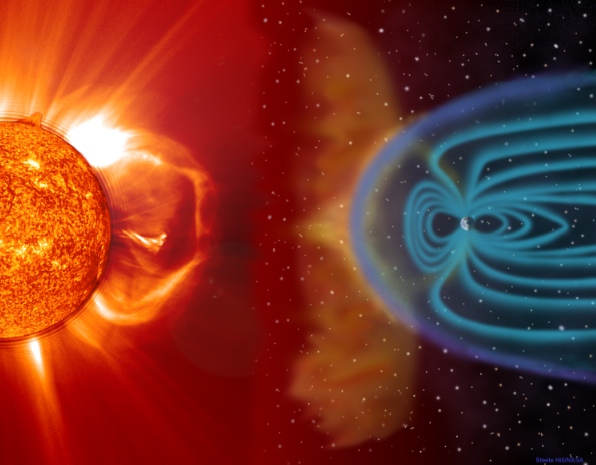

Last sentence, last paragraph. Is that a threat, or a promise? Seems to me the quality of your blog rose quite a bit without the presence of he(she) who was banned. For most of us, we can only comment on that which aligns with our interests.
Please, do not subject us to the dross of commentary pollution.
:)
It's... me hoping that a clean(er) comments section encourages more people to leave more on-topic, quality comments.
But the pickings were slim this week for the CotW, and I'd like to see that stepped up! So if I had to choose, I'd say it's more empty threat than promise. For whatever that's worth. (Maybe a clever commenter will liken this to when Obama said, "don't call my bluff.")
Kinda figured that to be the case.
On another topic, how about some 'Naughty NGC's' to replace the older 'Messy Mondays'? Sometimes a little visual stimulation goes quite a way.
By the way, good luck for Tuesday.
Free association based on this suggestion has led, to my amazement, that Annie Jump Cannon seems to have been mentioned just one time at SWAB. In a figure caption.
^ "to finding that Annie Jump Cannon"
@ Narad #4
Relevance to the (N)ational (G)alactic (C)atalogue ?
Also because it hasn't cleared its orbit. In terms of mass, Pluto is just a small fraction of the total mass in its orbit, which contrasts with the other planets, where the planet itself comprises the overwhelming fraction of mass in that orbital area.
One could argue that Neptune also shouldn't be a planet, because it hasn't cleared its orbit...of Pluto. :) The two, after all, cross orbits. But the mass difference between the two is something like four orders of magnitude, so even counting Pluto, Neptune itself comprises (AIUI) >99% of the mass in its orbital area.
No, that wasn't what I was talking about. I was talking about the warp drive's ability to create a form of absolute simultaneity. I synchronize two watches on Earth, load one up in the Enterprise, deliver it to Alpha Centauri a day later, and the two watches are still synchronized. I thought that should be theory-of-relativity impossible. But I'll admit my thinking on this is a bit mushy, and I could easily be confused here.
@eric #7: You wrote "I was talking about the warp drive’s ability to create a form of absolute simultaneity. I synchronize two watches on Earth, load one up in the Enterprise, deliver it to Alpha Centauri a day later, and the two watches are still synchronized. I thought that should be theory-of-relativity impossible."
I think you're getting to exactly the point. It's not that "the watches are still synchronized" is a problem. That's a simple statement of fact.
The problem is that warp-drive breaks relativity's basis for causality -- for unambiguously ordering events in time. If you have two events at the same spatial location which occur one after another (B comes after A), then in relativity there is no observer who could see those events happening in the opposite order. As your observer moves faster and faster, they'll see those events occur closer together in time (and at 'c' will seem them being simultaneous), but the order will never reverse.
For events separated in both space and time, there's a well-defined limit for events being causal (unambigously ordered) or not: If their separation in space is larger than their separation in time (using ct to keep the units the same for comparison), then such events _cannot_ be unambigously ordered for all observers. A consequence of that is that we claim that such events cannot be "causal" -- neither one could possibly have caused the other one.
But a warp drive breaks those rules.
"Well, hang on there. If Pluto were more massive — massive enough to be a true planet instead of a dwarf planet "
Of course, the term "Dwarf Planet" was invented as a sop to those who demanded Pluto remain a planet. It's not like Pluto is any different from Ceres, for example. And we changed the name of that from Planet to Asteroid without all this fuss and bother.
And didn't go riffing on "But if it were BIGGER, it would be a planet!!!".
Ceres getting 10x the size won't make it a planet.
If Pluto were 10x bigger, we would have no reason to use "Dwarf Planet" and keep a half-assed confusion going.
"I synchronize two watches on Earth, load one up in the Enterprise, deliver it to Alpha Centauri a day later, and the two watches are still synchronized. "
You could do that already. Did you mean bring one back again? So you'd have no twin paradox?
If so, you can do that with plain relativity: go at the speed of light. No time elapses on your journey there or back.
What would happen with a warp drive is that it would take "two days" from BOTH your (on Earth) and Kirk's (going to Alpha Centauri for a day return trip) if you could warp space enough to travel the shortened (warped) distance at a non-relativistic speed.
Warp is changing the distance you travel. Not moving you. You move within warp and travel that shorter distance just like normal.
The cinematics don't look like that, but they#re not concerned with reality.
"As your observer moves faster and faster, they’ll see those events occur closer together in time (and at ‘c’ will seem them being simultaneous), but the order will never reverse."
Warp doesn't change that, though.
The most it would do is create an inertial frame that you exist (as a warp drive engineer) in several places simultaneously.
However, either they would be significant distance apart or the multiplicity would be miniscule, because you still only have one lifeline and only a singular existence *from your point of view*.
You could travel to Jupiter and look back and, potentially, catch a few photons you emitted back on earth for 12 minutes or so, until you warp away to jupiter, but you would never then meet yourself arriving at that warp jump: it's already in the past of the you at Jupiter.
Ordering of events remains consistent.
I can? I'd like to know how you think I can deliver a watch to Alpha Centauri in one day and have the two watches remain synchronized.
That's "New General Catalogue" to you, buster. Like I said, it was free association.
Thanks for the correction, Narad. Thanks, also, for the education. Had never heard of A.J.C. before. :)
I was idly wondering about the task of examining photographic plates, now that I think back.
"I can? I’d like to know how you think I can deliver a watch to Alpha Centauri in one day and have the two watches remain synchronized."
Lets say you have a spacecraft that goes mach12 on average, or about 3000mph. If you warped space so that the distance for you from Earth to AC were less than about 600,000 miles, you could get to AC in one day, and relativistic effects would be invisible on a wristwach's mechanism.
Easy peasy.
Given the "if you could warp space".
And, no, you wouldn't be traveling faster than light. You only traveled a few hundred thousand miles.